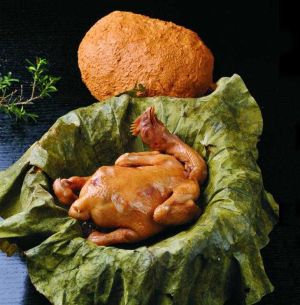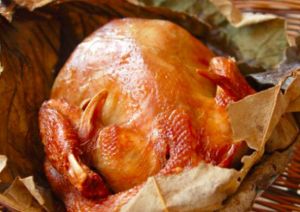Beggar’s Chicken
Introduce
“Beggar’s chicken”, also called Changshu beggar’s chicken, braised chicken(Simplified Chinese: 叫花鸡; Traditional Chinese: 叫花雞; Pinyin: jiào huā jī ), is a traditional famous dish in Changshu, Jiangsu province, which applies mud and lotus leaves to cover prepared chick. The raw materials include fresh lotus leaves, yellow mud and live free ranch chicken etc.
Taste
Salty, delicious.
Characteristics
The color of this dish is purplish red and brightening. It is with special flavor, extremely fragrant with crisp bones and tender meat, and tastes meaty and tender.
In Chinese(Pronunciation)
Simplified Chinese: 叫花鸡;
Traditional Chinese: 叫花雞;
Pinyin: jiào huā jī ;
Nutrition
Calories (kcal) 170.89(Per 100 grams)
Carbohydrate (g) 1.20(Per 100 grams)
Fat (g) 7.30(Per 100 grams)
Protein (g) 24.10(Per 100 grams)
Calories
Beggar’s Chicken (Jiao Hua Ji) is estimated to be 171 kcal.
Origin
It is said that a beggar got a chicken, but he has no place to cook it. So, he slaughtered it without cleaning and de-hairy, and covered with lotus leaf and mud and put it into furnace. When the chicken is roughly well-done, he took it out and smashed the mud and ate it. It came out to be a delicious, and “Beggar’s chicken” spreads out from this moment on.
History
“Beggar’s chicken” originates from Changshu, Jiangsu province. Some refugees (also called beggars) stole some chicken and covered them with mud and roasted it. When the mud is roasted dry, the chicken is also well-done. It is not an elegant dish. It is said that emperor Qianlong wore plain clothes to visit south regions of Yangtze River and carelessly wandered wildness. There is a beggar who felt very sorry for him and served him “Beggar’s chicken” that is considered the delicious himself. Emperor Qianlong was in status of hungry and hardship, and naturally feels this chicken is very delicious. After having it, Emperor Qianlong asked the name of this dish, and the beggar embarrassedly to answer “Beggar’s chicken”, so talked irresponsibly “Fortune chicken”. Emperor Qianlong praised highly for this chicken. Latterly, the beggar knows this wanderer is Emperor Qianlong, and this “Beggar’s chicken” turns into “Fortune chicken” and passed so far and has become an elegant dish.
Health
The wisdom fulfilling civilian delicious “Beggar’s chicken” exquisitely seals and roasts food in high temperature furnace retaining juice and fragrance to a great extent.
Ingredients
Fresh and tender lotus leaves
Plenty of mud
Live free-rang chicken
N meter long cotton thread.
Recipe
Step 1
Twist neck of chicken, no blood-letting, retain hair;
Step 2
Cut a gap as little as you can at anal and remove the giblet and clean them;
Step 3
Scribble seasoning condiments or fragrance in the cavity according to personal taste. Normally the fragrance is not added in due to the lotus fragrance may be easily covered by it;
Step 4
Mix yellow mud with water to until it becomes viscous, and scribble fully and evenly on chicken to form a ellipsoid type;
Step 5
Wrap it tight using lotus leaves and bundle it up using cotton thread;
Step 6
Dig a hole and bury it in and fill up, and keep the chicken 10 cm beneath the ground;
Step 7
Make a bonfire on it and evenly heat it up, when the fire naturally burns out and cools down, dig the chicken out and smash the mud off with the hair easily and have the delicious.


